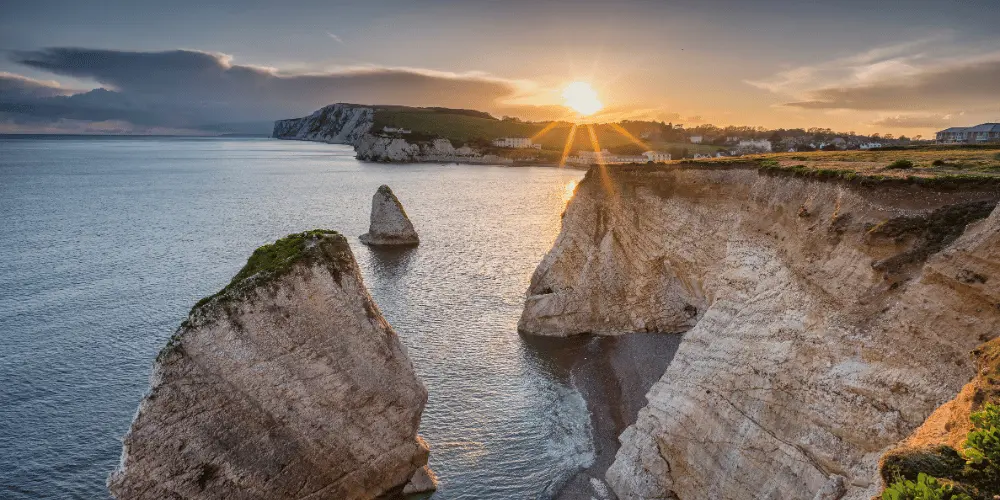River Waveney: A Traveler’s Journey Through Historic Mills, Wildlife Sanctuaries & Cultural Heritage
Stretching 59 miles along the scenic Norfolk-Suffolk border, the River Waveney is a haven of natural beauty and historical richness.
From its source at Redgrave and Lopham Fen to its confluence with the River Yare near Great Yarmouth, the Waveney offers serene landscapes, quaint villages, and a rich cultural tapestry.
The Source at Redgrave and Lopham Fen
Redgrave and Lopham Fen, the river’s source, is a nature reserve teeming with biodiversity.
This area is home to a myriad of wildlife, including otters, kingfishers, and water voles.
The fen’s diverse habitats provide a tranquil start to the river’s journey, gradually giving way to the rolling landscapes of East Anglia.
Roger Deakin’s Influence: ‘Waterlog’
The River Waveney gained literary fame through Roger Deakin’s celebrated book “Waterlog.”
Deakin’s passion for wild swimming and his descriptive accounts of the river’s serene spots inspired many to explore and appreciate the natural waters of Britain.
His evocative writings helped to popularize the Waveney, turning it into a beloved destination for nature enthusiasts and swimmers alike.
This chapter sets the stage for a deeper exploration of the River Waveney’s rich historical heritage and its vibrant natural wonders, ensuring every bend in the river offers a new adventure waiting to be discovered.
Historical Heritage and Cultural Landmarks
Historic Drainage Mills
One of the River Waveney’s most notable features is its historic drainage mills, which played a pivotal role in the region’s agricultural development.
These mills were essential for marshland management, draining the surrounding areas to make them suitable for farming.
The landscape along the Waveney is adorned with these robust structures, serving as silent sentinels of an industrious past.
The Herringfleet smock mill stands out as a celebrated landmark and the oldest drainage mill in the Broads area.
With its wooden sails and classic design, it offers a glimpse into the engineering marvels of yesteryears, attracting both history buffs and casual visitors.
Bungay’s 12th-Century Castle
Another gem in the Waveney’s historical crown is Bungay’s 12th-century castle.
This ancient structure provides a fascinating window into the turbulent history of the region.
The castle grounds invite visitors for a leisurely exploration, allowing them to imagine the fortifications and battles that once shaped its story.
Moreover, Bungay is shrouded in the eerie yet captivating legend of the Black Dog, known as Black Shuck.
According to local tales, this ghostly hound roamed the town, appearing in the church during a storm, leaving marks that are still visible today.
This lore adds a mysterious layer to Bungay’s historic fabric, making it an intriguing stop along the river.
The Role of Drainage Mills in Marshland Management and Agriculture
Drainage mills were not merely historical artifacts; they were the lifeblood of marshland management and agriculture in the Waveney Valley.
By effectively draining water from the marshes, these mills transformed the landscape, making extensive agricultural endeavors possible.
The efficiency of these mills ensured that the once-wet and marshy lands were converted into fertile farmlands that could sustain crops and support the local economy.
Although some of these mills have succumbed to time and nature, many still stand proudly, reflecting the ingenuity and hard work of past generations.
As you delve deeper into the historical heritage of the River Waveney, its rich cultural tapestry and picturesque landscapes continue to reveal new stories and adventures.
Natural Wonders and Wildlife Encounters
Diverse Wildlife
The River Waveney is a treasure trox of diverse wildlife.
Along this picturesque waterway, you might spot otters basking on floating logs, kingfishers darting across the water, and water voles nesting along the banks.
The Waveney provides a safe haven for these species, thriving well compared to many other areas in the UK.
Seasonal Transformations
The Waveney’s beauty is enhanced by its stunning seasonal transformations.
In winter, the landscape becomes a serene wonderland of frost-kissed reeds and ghostly drainage mills.
As spring arrives, the lively scene is painted with floating willow seeds and new blossoms, a vibrant canvas in motion.
Summer brings an orchestra of birdsong and a bustling ecosystem, while autumn decorates the river in rich, warm hues, perfect for reflective strolls along the banks.
Secret Pools and Willow-Shaded Bends
Scattered along the river’s course are secret pools and willow-shaded bends that offer perfect spots for nature observation and tranquil escapes.
These secluded retreats are ideal for a peaceful picnic or a serene dip in the water.
The willow-shaded bends further enhance the river’s charm, creating magical nooks that invite visitors to pause and enjoy the harmony of nature.
Exploring these natural wonders allows visitors to immerse themselves in the River Waveney’s serene beauty and rich biodiversity, making it a destination that seamlessly blends history, nature, and adventure.
Outdoor Activities and Adventures
Scenic Cycling Routes
Enthusiasts of cycling will find the River Waveney area a haven for two-wheeled adventures.
Spanning an extensive 104 miles, these cycling routes meander through gentle river valleys and quaint historic villages.
The journey can conveniently commence from Diss railway station. Pedal through charming locales like Bungay and Beccles, where the valley’s serene landscapes unfold.
Discover the majestic Oulton Broads, where marshlands and historical monuments decorate the scenic ride.
The landscape is refreshingly devoid of heavy development, ensuring an uninterrupted and peaceful journey.
This combination of natural beauty and historical whimsy offers a rewarding experience for cyclists of all skill levels.
Wild Swimming Hotspots
The River Waveney, famously popularized by Roger Deakin’s ‘Waterlog’, has become an epicenter for wild swimming enthusiasts.
The river hosts numerous secret pools and sandy beaches, perfect for an invigorating dip.
Inspired by Deakin’s legendary swims, these serene spots provide an ideal retreat for those seeking to immerse themselves in nature.
The tranquil waters and secluded locations create a perfect environment to relax and reconnect with the natural world.
Angles Way Walking Trails
For those who prefer adventures on foot, the Angles Way trail promises a rewarding experience.
Stretching from Knettishall Heath to Great Yarmouth, this trail aligns with the river’s course at various points.
Walkers can enjoy tranquil pauses by willow-shaded bends, historic drainage mills, and breathtaking countryside vistas.
The Angles Way trail allows for immersion in the serene landscapes of the Waveney while uncovering historic and natural treasures at every turn.
Embarking on these activities not only offers new experiences and cherished memories but also allows visitors to fully appreciate the stunning natural beauty and rich history of the River Waveney.
As you explore, each bend of the river promises something unique and enchanting.
The journey through outdoor activities at the River Waveney continues to be an invitation to adventure and discovery.
Local Culture and Culinary Experiences
Craft Breweries and Indie Cafes
Exploring the River Waveney means immersing yourself in the local culture, and what better way to start than by sampling the region’s craft beers and specialty coffees? At the forefront is Ampersand Brew Co.
in Harleston, where the inventive brews like Bidon pale ale and Basil Blush with raspberry provide a delightful taste of the local beer scene.
This is a must-visit for anyone interested in experiencing the creativity and passion that goes into each craft beer.
Coffee enthusiasts should head to Earsham Street Café in Bungay.
Their Ethiopian coffee blend not only offers an invigorating caffeine fix but also a cozy spot to relax and plan your next adventure along the river.
The café’s charming ambiance and locally-sourced goodies make it a perfect stop for both locals and visitors.
Historic Pubs and Inns
The River Waveney is dotted with historical pubs that provide cozy retreats after a day of exploring.
Among the most notable is the Geldeston Lock Inn.
This charming pub, nestled near the river, offers a rustic atmosphere, live music, and a friendly environment.
It’s the ideal spot to unwind with a pint in hand after a day of kayaking or cycling.
The inn’s history and character make it not just a place to eat and drink, but an essential part of any visit to the region.
Local Delicacies
As you journey through the quaint villages along the River Waveney, delight in the variety of local delicacies from independent cafes and eateries.
Fresh seafood, homemade pastries, and traditional Suffolk dishes are in abundance.
Each establishment, from the charming cafes to the family-owned restaurants, contributes to the rich culinary tapestry of the Waveney Valley.
Savoring these local gems adds depth to your travel experience, offering glimpses into the heart of the community and its traditions.
As you relish each unique flavor, remember that the charm and beauty of the River Waveney lie not only in its waters and landscapes but also in the warmth and hospitality of its people.
Conservation and Sustainable Tourism
Ongoing Initiatives to Protect Wildlife and Water Quality
Efforts to ensure the River Waveney remains a haven for wildlife and supports clean water are multifaceted and ongoing.
Conservationists and local councils are dedicated to maintaining the health of this beautiful waterway.
These includes:
- ✅Monitoring pollution levels: Regular water quality checks help in identifying and mitigating pollution, ensuring the river remains clear and healthy.
- ✅Promoting organic farming practices: Encouraging farmers near the river to adopt organic methods reduces chemical runoff, benefiting the water and its inhabitants.
- ✅Enhancing sewage treatment facilities: Upgrading local sewage treatment plants minimizes harmful discharges into the river, protecting aquatic life.
These initiatives have a significant focus on iconic species like otters, kingfishers, and water voles, ensuring their populations thrive.
By protecting these species, the entire ecosystem benefits, creating a rich and varied natural environment.
Responsible Tourism Practices and Visitor Guidelines
With the increasing popularity of the River Waveney as a tourist destination, it’s crucial to promote responsible tourism practices to preserve its natural beauty.
Visitors are encouraged to:
- ✅Respect local wildlife by observing animals from a distance and avoiding any disturbance.
- ✅Stay on designated paths to limit damage to natural habitats and prevent erosion.
- ✅Dispose of waste properly: Carry out what you carry in and use appropriate waste facilities to keep the riverbanks clean.
Additionally, swimming in the river should be avoided for 48 hours after heavy rainfall to prevent exposure to pollution runoff, a measure highlights for maintaining both visitor and environmental health.
Preservation Efforts for Historical Features and Natural Habitats
The preservation of the River Waveney’s historical features and natural habitats is a collaborative effort involving local organizations and volunteers.
Key activities include:
- ✅Cleaning riverbanks and removing debris: Regular clean-up events help keep the river and its surroundings pristine.
- ✅Planting native species: Enhancing local flora supports the natural habitat and encourages biodiversity.
- ✅Restoring natural habitats: Efforts to recreate and maintain environments for wildlife contribute to the river’s ecological health.
Historic structures, such as the Herringfleet smock drainage mill, are also part of these preservation efforts.
Maintaining these mills not only preserves but also adds to the scenic beauty and cultural richness of the region.
With the careful implementation of these conservation and sustainable tourism practices, the River Waveney continues to thrive as a treasured natural sanctuary, offering rich experiences for generations to come.







